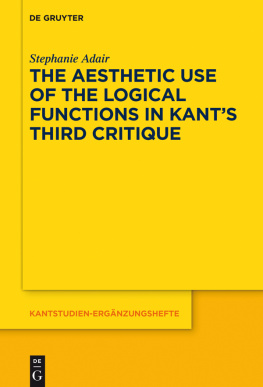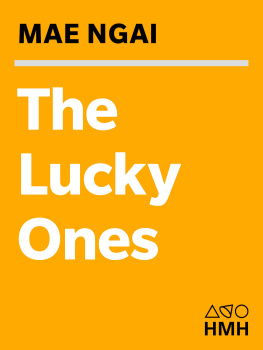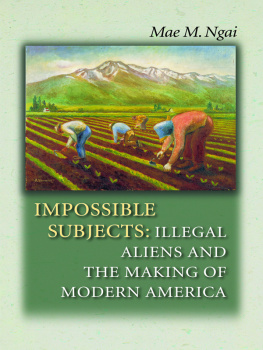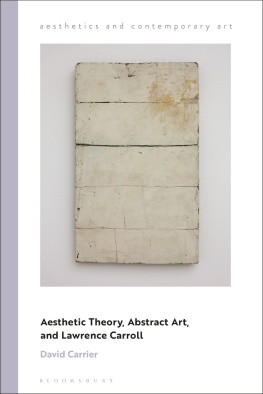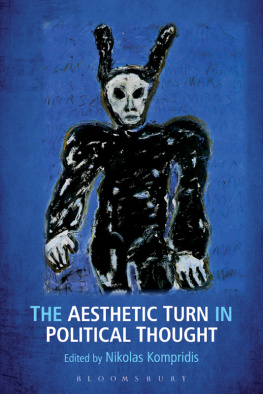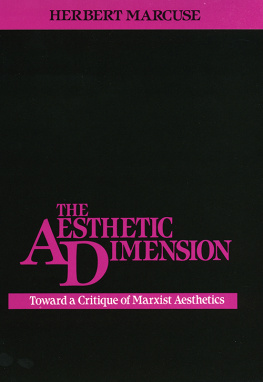Sianne Ngai - Theory of the Gimmick: Aesthetic Judgment and Capitalist Form
Here you can read online Sianne Ngai - Theory of the Gimmick: Aesthetic Judgment and Capitalist Form full text of the book (entire story) in english for free. Download pdf and epub, get meaning, cover and reviews about this ebook. publisher: Harvard University Press, genre: Romance novel. Description of the work, (preface) as well as reviews are available. Best literature library LitArk.com created for fans of good reading and offers a wide selection of genres:
Romance novel
Science fiction
Adventure
Detective
Science
History
Home and family
Prose
Art
Politics
Computer
Non-fiction
Religion
Business
Children
Humor
Choose a favorite category and find really read worthwhile books. Enjoy immersion in the world of imagination, feel the emotions of the characters or learn something new for yourself, make an fascinating discovery.

- Book:Theory of the Gimmick: Aesthetic Judgment and Capitalist Form
- Author:
- Publisher:Harvard University Press
- Genre:
- Rating:4 / 5
- Favourites:Add to favourites
- Your mark:
- 80
- 1
- 2
- 3
- 4
- 5
Theory of the Gimmick: Aesthetic Judgment and Capitalist Form: summary, description and annotation
We offer to read an annotation, description, summary or preface (depends on what the author of the book "Theory of the Gimmick: Aesthetic Judgment and Capitalist Form" wrote himself). If you haven't found the necessary information about the book — write in the comments, we will try to find it.
Theory of the Gimmick: Aesthetic Judgment and Capitalist Form — read online for free the complete book (whole text) full work
Below is the text of the book, divided by pages. System saving the place of the last page read, allows you to conveniently read the book "Theory of the Gimmick: Aesthetic Judgment and Capitalist Form" online for free, without having to search again every time where you left off. Put a bookmark, and you can go to the page where you finished reading at any time.
Font size:
Interval:
Bookmark:

THEORY OF THE GIMMICK
Aesthetic Judgment and Capitalist Form
Sianne Ngai
THE BELKNAP PRESS OF
HARVARD UNIVERSITY PRESS
Cambridge, Massachusetts
London, England
2020
Copyright 2020 by the President and Fellows of Harvard College
All rights reserved
Cover photograph: Flame, 1947 Stan Douglas
Cover design: Tim Jones
978-0-674-98454-7 (cloth)
978-0-674-24531-0 (EPUB)
978-0-674-24534-1 (MOBI)
978-0-674-24536-5 (PDF)
The Library of Congress has cataloged the printed edition as follows:
Names: Ngai, Sianne, author.
Title: Theory of the gimmick : aesthetic judgment and capitalist form / Sianne Ngai.
Description: Cambridge, Massachusetts : The Belknap Press of Harvard University Press, 2020. | Includes bibliographical references and index.
Identifiers: LCCN 2019038757
Subjects: LCSH: Aesthetics, Modern20th century. | Aesthetics, Modern21st century. | Aesthetics, ModernPhilosophy. | Hoaxes. | Influence (Literary, artistic, etc.) | Capitalism.
Classification: LCC BH201 .N49 2020 | DDC 111/.85dc23
LC record available at https://lccn.loc.gov/2019038757
For Hans Thomalla
This book is about the irritating yet strangely attractive gimmick as an aesthetic judgment and capitalist form. Focusing on an ambivalent judgment tied to a compromised form, it underscores the fact that aesthetic categories have two sidesthe judgment we utter, a way of speaking; the form we perceive, a way of seeingsutured by affect into a spontaneous experience. In the case of the extravagantly impoverished, simultaneously overperforming and underperforming gimmick, we are dealing with an aesthetic specific to a mode of production that binds value to labor and time, giving rise to a unique set of collectively generated abstractions and peculiarly asocial kinds of sociality.
Always dubious if never entirely unappealing, the gimmick wears multiple faces. It can be a catchy hook, a timeworn joke, a labor-saving contraption. In the studies that follow, we will encounter it in even more specific guises: as a smiley face, a financial strategy, a readymade artwork that interprets itself. Gimmicks are fundamentally one thing across these instances: overrated devices that strike us as working too little (labor-saving tricks) but also as working too hard (strained efforts to get our attention). In each case we refer to the aesthetically suspicious object as a contrivance, an ambiguous term equally applicable to ideas, techniques, and things.
In our everyday encounter with the gimmick, we are thus registering an uncertainty about laborits deficiency or excessthat is also an uncertainty about value and time. These metrics become inseparable in a system necessitating unceasing innovation as competing capitals move around the world in search of profit, expelling labor from abandoned lines. Each variable determines and is necessary for expressing the others. The gimmick thus acquires its reputation of bad timingbeing too old or too newbased on its deviation from a tacit standard of productivity. Under- or overperforming with respect to this historical norm, it strikes us as technologically backward or just as problematically advanced: futuristic to the point of hubris, as in the case of Google Glass, or comically outdated, like the choreographed jerks used to simulate turbulence in television episodes of Star Trek.
Finally, as what we call devices that strike us as cheap even when we know they were expensive to develop, the gimmick is a judgment that asks us, in a well-nigh blasphemous way, to conflate aesthetic value with economic valuemoneyand more specifically, unproductively utilized money. For one of the gimmicks paradigmatic instances is the overrated product one would be a sucker to buy, and thus an unsold commodity whose value cannot be realized. Yet from the stainless steel banana slicer to the cryptocurrency derivative, our very concept of the gimmick implies awareness that, in capitalism, misprized things are bought and sold continuously. Its flagrantly unworthy form can be found virtually anywhere: manufacturing, law, banking, education, politics, healthcare, real estate, sports, art.
The gimmick is thus capitalisms most successful aesthetic category but also its biggest embarrassment and structural problem. With its dubious yet attractive promises about the saving of time, the reduction of labor, and the expansion of value, it gives us tantalizing glimpses of a world in which social life will no longer be organized by labor, while indexing one that continuously regenerates the conditions keeping labors social necessity in place.
Notice how the appraisals of labor, time, and value that our judgment of the gimmick conjoins are left unparticularized, as if implicitly grasped as historically relative and moving. This is strikingly akin to Kants judgment of beauty, which not only claims universality in the absence of concepts, but as Rodolphe Gasch suggests, denudes or strips the concept of content, retaining it as bare form, or in Kants words, merely formal (blo). None of the appraisals encoded in our judgment of the gimmick thus interfere with its affective spontaneity. Rather, our experience of the gimmick underscores the surprisingly dynamic formalismthe formalizing activityof aesthetic judgment overall. Grounded in feelings activated by appearance, as opposed to in concepts, rules, or laws, aesthetic judgment is by definition neither cognitive nor practical. Yet such judgments are crucially elicited in its immediate aftermath. In the gimmick, specifically, our spontaneously affective, explicitly aesthetic appraisal of an objects form as unsatisfyingly compromised triggers and comes to overlap with economic and ethical evaluations of it as cheap and fraudulent.
Labor, time, and value are of course interconnected nonaesthetically through the billions of interactions between capital and labor that enable the calculation of wages, profit, and interest. This interconnection presupposes a mode of production involving competition between capitals, the equalization of intrasectoral profit rates, and the structurally compelled transformation of labor processes toward increasing productivity. If the gimmick seems too expensive or too cheap, it is because the technology behind it is too new or too old. And the fact of technology being too new or old often directly accounts for why a gimmick seems to be over- or underperforming. These relations hold true in reverse. If the gimmick seems to be working too hard or too little, it is because the social timing of its appearance is off. And when it is said that a productive technology has arrived too early, what is meant is that its cost is proving too high.
These ratios get filtered into the conscious and unconscious decisions of all producers and consumers. Yet each carries a seed of worry that the gimmick objectifies. If the overworking device generates the image of too many goods produced per hour for the market to absorb, its underworking twin generates the image of not enough goods produced per hour for a producer to stay competitive. These images in turn invoke bigger specters, such as overproduction or underconsumption (leading to surplus or idle capitals), structural unemployment (leading to surplus populations), and economic stagnation. All lurk at the edges of our sensory encounter with the gimmicks ostentatiously impoverished form.
Font size:
Interval:
Bookmark:
Similar books «Theory of the Gimmick: Aesthetic Judgment and Capitalist Form»
Look at similar books to Theory of the Gimmick: Aesthetic Judgment and Capitalist Form. We have selected literature similar in name and meaning in the hope of providing readers with more options to find new, interesting, not yet read works.
Discussion, reviews of the book Theory of the Gimmick: Aesthetic Judgment and Capitalist Form and just readers' own opinions. Leave your comments, write what you think about the work, its meaning or the main characters. Specify what exactly you liked and what you didn't like, and why you think so.


